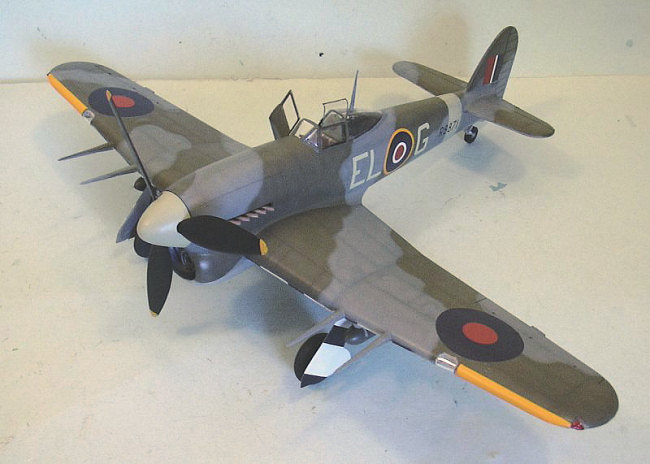
Revell 1/32 Typhoon IB
| KIT #: | ? |
| PRICE: | $ Currently out of production |
| DECALS: | one option |
| REVIEWER: | Tom Cleaver |
| NOTES: |

| HISTORY |
Traditionally, the hallmark of a successful aircraft manufacturing company has been that future requirements should always be the concern of the Chief Designer and the project team. In other words, when the latest project has been accepted for production, its replacement should be on the drawing board. Sir Sydney Camm, Hawker Aircraft's Chief Designer - and one of the true legends of aircraft design alongside Ed Heineman and Kelly Johnson - was already hard at work in the summer of 1937 on the Hurricane's replacement, designed to meet Air Ministry Specification F.18/37 which called for a fighter with a top speed over 400 m.p.h. when the first production model of that famous airplane had yet to fly.
The result was - at the time the first prototype was rolled out - the biggest single-seat, single-engine fighter ever designed, with the heaviest armament any traditional fighter had ever carried, and the most powerful engine ever installed in an airframe. Unfortunately, not enough was known at the time of its design to prevent it being equipped with a wing too thick for what was really needed, which would always hold it back in fighter versus fighter performance. The exigencies of war would dictate that the airplane was committed to production too early in the development cycle, resulting in it acquiring a worse reputation with its pilots than any fighter that ever preceded it, a dangerous reputation that was fully deserved at the outset, that would cost the lives of many young fighter pilots to resolve, and would still not be fully fixed by the end of the aircraft’s career.
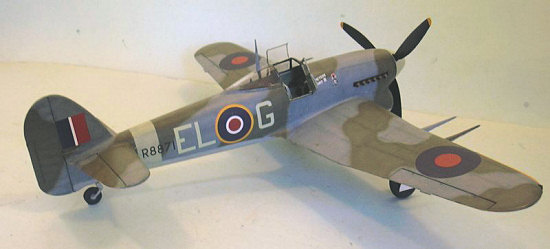 In
the end, all the heartache would be justified, as it became the primary weapon
of close air support for the Allies alongside the P-47 Thunderbolt, covering the
victorious Allied armies as they swept across northwestern Europe in the
breakout from Normandy in the eleven months between D-Day and V-E Day. As a
killer of German armored vehicles, it would only be out-done by the Russian
Shturmovik.
In
the end, all the heartache would be justified, as it became the primary weapon
of close air support for the Allies alongside the P-47 Thunderbolt, covering the
victorious Allied armies as they swept across northwestern Europe in the
breakout from Normandy in the eleven months between D-Day and V-E Day. As a
killer of German armored vehicles, it would only be out-done by the Russian
Shturmovik.
The airplane was the Hawker Typhoon, the first all-metal airplane produced by Hawker Aircraft. Originally designed to carry 12 .303 machineguns, it was redesigned to carry the then-unheard-of armament of four 20mm cannon, and was powered by the Napier Sabre, the first 2,000 h.p. engine. Ordered "off the drawing board" in 1939, the prototype Typhoon flew on February 24, 1940. It became the subject of a quantity production order to be assigned to Gloster Aircraft, since Hawkers was thoroughly committed to the Hurricane and later to the Tempest.
Fortunately for the Typhoon, the Battle of Britain intervened before it could enter large-scale production and it lost all priority until October 1940. This allowed some of the plethora of problems that had manifested themselves with the Sabre engine to be dealt with.
Flight testing quickly revealed the dangerous effects of compressibility, of which little was known at the time. The thick wing also resulted in extreme slipstream buffet around the wing roots, due to the fact the engine was fitted as close to the leading edge of the wing as possible to preserve c.g. balance. Unknown at the time was the fact that the buffet also created a disturbed slipstream along the entire fuselage that became quite violent by the time it reached the tail. It would be early 1943 before it was discovered that the fuselage/tail joint was not strong enough to withstand these forces in a maximum-velocity dive, with the result that the joint was reinforced with the fishplates so prominent on the Typhoon afterwards. Nineteen pilots died due to catastrophic tail separation discovering this solution, which was the result of the sped-up development process.
The first Typhoon IA - with the 12 machinegun armament - was completed by
Gloster on May 26, 1941. After a limited production run of this type, the
cannon-armed Typhoon IB appeared in early July. By that fall, the RAF had
encountered the Focke-Wulf Fw-190, and needed the Typhoon more than ever. 56
Squadron at Duxford received their first Typhoons in September, 1941; they were
followed in January 1942 by 266 "Rhodesian" Squadron and 609 "West Riding"
Squadron the following March. Due to the lack of development, these squadrons
would by necessity become part of the flight testing of the
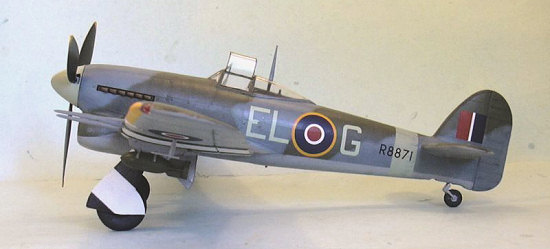 Typhoon to unearth
solutions to its many faults. One of the first items the pilots of 56 discovered
was that the pilot had to wear his oxygen mask at all times, due to the leakage
of carbon monoxide into the cockpit from the engine compartment.
Typhoon to unearth
solutions to its many faults. One of the first items the pilots of 56 discovered
was that the pilot had to wear his oxygen mask at all times, due to the leakage
of carbon monoxide into the cockpit from the engine compartment.
The price of the premature introduction of the Typhoon was high. Despite being issued to 56 Squadron in September 1941, the first operational sortie - an interception of a "bogie" that turned out to be a Spitfire - was not flown until May 28, 1942. The first “Rodeo” sweep was flown on June 20. During the first nine months of operations, far more Typhoons were lost due to structural failure or engine trouble than were lost on operations. Between July and September 1942, it was estimated at least one Typhoon in four failed to return from an operational sortie as a result of one of its many defects.
The Typhoon in Combat:
The Typhoon scored its first aerial victory in August 1942, when Pilot Officers Munro and Lucas of 56 Squadron - flying respectively a cannon-armed Typhoon IB and a machine-gun armed Typhoon IA - caught a Junkers Ju-88 50 miles off Cromer, on the Norfolk coast, and shot it into the sea.
The Typhoon first entered large-scale combat in the Dieppe Raid on August 19, 1942, with the Duxford Wing claiming one Do-217E shot down. From then on, the wing became more and more involved in countering the "tip and run" raids by the Fw-190A-4/U4 "Jabos" of JG26 and JG2, and later SKG10, with the squadrons operating from Biggin Hill and Manston as well as Duxford and Warmwell. By September, No's 1, 486 and 257 Squadrons had converted on to the Typhoon.
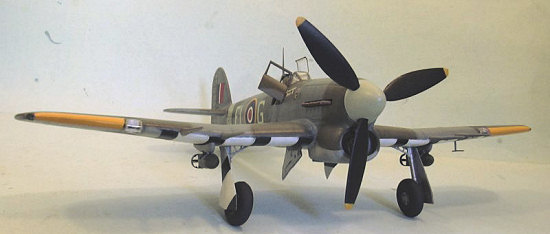 Group Captain Roland “Bee” Beamont, one of the leading Typhoon pilots in the
early days of 1942 and 1943, put it well in describing the difference between
the Typhoon and what had come before:
Group Captain Roland “Bee” Beamont, one of the leading Typhoon pilots in the
early days of 1942 and 1943, put it well in describing the difference between
the Typhoon and what had come before:
“...a new breed of fighter pilot had emerged. The traditional Spitfire ‘fighter boys’ were still much in evidence and in demand for their essential work of establishing and maintaining air superiority, but the ‘mod-movers’ of the Typhoon force... had become a rough, take-on-anything group of dedicated low-attack pilots, confident in their ability to take their massive fighters through anything the enemy, or the weather, had to offer, and to strike their targets accurately and hard with rockets, bombs, or their favourite 20mm cannon.”
Denis Crowley-Milling:
Air Marshal Sir Dennis Crowley-Milling, the son of a Lancastrian solicitor, began his RAF career when he left Malvern College in 1937 to take up an apprenticeship with Rolls Royce and became a member of the RAF Volunteer Reserve. As a Sergeant Pilot with 615 (County of Surrey) Squadron, Royal Auxiliary Air Force in 1939, he flew Gladiators until the unit converted to Hurricanes in May 1940. Having been promoted to Pilot Officer in March 1940, he was transferred to 242 Squadron, then in France, in early June. His experience as an apprentice at the Rolls-Royce aero-engine experimental unit at Derby paid dividends when he was able to service the Hurricanes left behind in France for lack of crews to care for them, and thus make good the squadron’s escape back to England on June 18, 1940.
Following the arrival of Douglas Bader as Squadron Leader of 242 Squadron that July, “Crow” flew as Bader’s Number 2 during the Battle of Britain, where he was promoted to Flight Lieutenant and was shot down on September 7 during the first attack of Bader’s “Big Wing.” In June 1941, he became A Flight Commander in 610 Squadron, a unit of Bader’s Tangmere Wing. Shot down over France on August 21, 1941, he was at first suspected by the Resistance of being a German posing as an RAF pilot, and came close to being shot. However, with the help of the French Resistance, he evaded and got to Spain that October, where he was captured by the Guardia Civil and placed in a Spanish concentration camp where he contracted paratyphoid. Repatriated to England in December 1941, he returned to his position of Flight Commander with 610 Squadron.
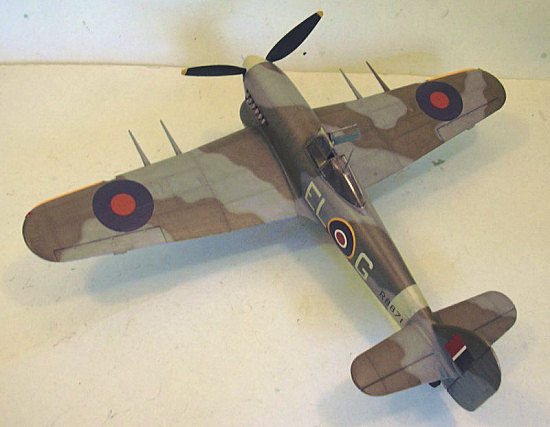 In
August 1941 he was promoted to Squadron Leader and given command of 181 Squadron
at Duxford, the first Typhoon squadron to be assigned to the low-level
fighter-bomber role. Squadron Leader Crowley-Milling trained the squadron
through the fall of 1942, and they entered combat in the Spring of 1943, flying
low-level bombing raids over northern France and the Low Countries, where they
pioneered the tactics that would later be used when the Typhoon became the
leading RAF ground-attack aircraft following the Normandy Invasion. One of his
pilots recalled, "Only a few years older than us - he was 23 - he had masses of
experience and made operations seem like a walk in the park." That June 4, he
was promoted to Wing Commander and given command of 121 Wing, which comprised
181 and 182 Squadrons. He led the wing in many low-level attacks against rail
targets and shipping in the English Channel until his tour expired in October
1943, when he became the RAF Liaison Officer with USAAF HQ.
In
August 1941 he was promoted to Squadron Leader and given command of 181 Squadron
at Duxford, the first Typhoon squadron to be assigned to the low-level
fighter-bomber role. Squadron Leader Crowley-Milling trained the squadron
through the fall of 1942, and they entered combat in the Spring of 1943, flying
low-level bombing raids over northern France and the Low Countries, where they
pioneered the tactics that would later be used when the Typhoon became the
leading RAF ground-attack aircraft following the Normandy Invasion. One of his
pilots recalled, "Only a few years older than us - he was 23 - he had masses of
experience and made operations seem like a walk in the park." That June 4, he
was promoted to Wing Commander and given command of 121 Wing, which comprised
181 and 182 Squadrons. He led the wing in many low-level attacks against rail
targets and shipping in the English Channel until his tour expired in October
1943, when he became the RAF Liaison Officer with USAAF HQ.
Wing Commander Crowley-Milling remained in the RAF post-war as a permanent rank Squadron Leader and retired as an Air Marshal in 1975, by which time - as Commander RAF Staff and Principal Air Attache in Washington D.C. from 1967 to 1970 - he had been instrumental in the adoption of the Harrier by the U.S. Marines. Following retirement, he was appointed Controller of the RAF Benevolent Fund where he introduced the International Air Tattoo, an event which went on to become one of the most popular aviation events in Europe. From 1992 until his death in 1996, Air Marshal Sir Denis Crowley-Milling was Master of the Guild of Air Pilots and Navigators.
| THE KIT |
Revell released their 1/32 Typhoon in the early to mid 1970s, as I recall. It
was remarkable for being the first “car door” Typhoon released as a model. The
kit has been in and out of production over the intervening years. Most
recently, it formed the 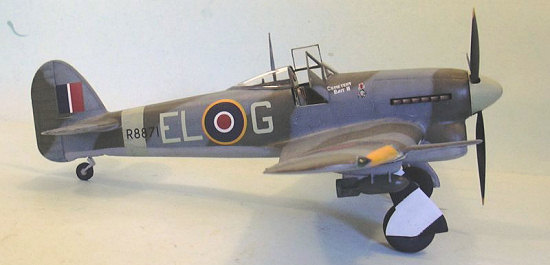 basis for the MDC full-resin “bubbletop” Typhoon
released two years ago.
basis for the MDC full-resin “bubbletop” Typhoon
released two years ago.
The kit is simple, and the parts fit is what one expects from a 1970s kit. The raised detail is voluminous, with lots of small rivets - which are all located in the right places. Checking out the kit, one can see that Revell did intend a later release of the “bubbletop” kit as can be seen from the mold insert in the upper fuselage and the fact that the interiors of the lower wings have covered-over locating holes for the rocket rails that version carried.
I found this particular kit at a dealer’s table last fall at the Antelope Valley show, where it cost $20. This is - I believe - the most recent re-release of the kit, with the thin Revell-Monogram box and the kit molded in light grey plastic rather than the light green it originally came in. Additionally, the decals - which provide markings for “Mavis” of 609 Squadron - are produced by Invisi-clear, which marks this as an early-1990s release.
| CONSTRUCTION |
Looking closely at the surface detail of this kit, I concluded that if it was sanded down until the raised detail was just apparent as I ran my fingertips over it, it would be far more “right” than the engraved rivet one finds on kits nowadays. I therefore sanded down all the parts before assembly, and carefully filled the area around the cockpit plug, which had a noticeable “sink,” with cyanoacrylate glue that I allowed to cure “naturally,” which gave a pretty flat surface. By doing the least possible and sanding carefully, I avoided loosing a lot of detail, and was able to rescribe the rivets with my pounce wheel. I then engraved the panel detail with a Number 11 X-Acto blade.
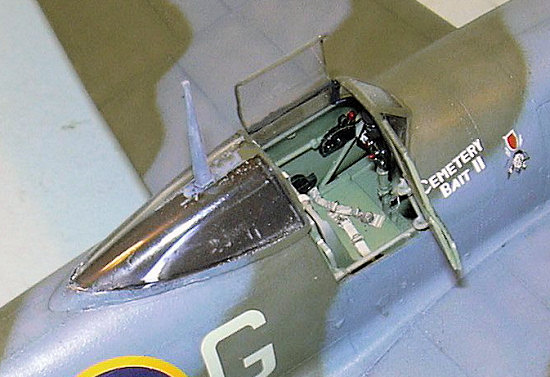 Next, I carefully glued the open engine cowling panel in place, again using
cyanoacrylate glue to fill the panel lines, which I then rescribed after sanding
the area smooth.
Next, I carefully glued the open engine cowling panel in place, again using
cyanoacrylate glue to fill the panel lines, which I then rescribed after sanding
the area smooth.
Next I painted the cockpit and assembled it. The instrument panel decal was too big, so I ended up using some individual instrument decals. I also used the Eduard photo-etch 1/32 RAF Sutton Harness. While that was drying, I assembled the engine and attached it, then carefully assembled the fuselage halves. I had cut off the locating pins so I could get as exact a fit as possible, and only had to scrape down the centerline with my Xacto, without losing surface detail.
I then assembled the wing and set it aside. I slid the cockpit into position, and glued it in, then attached the wing to the fuselage. Fit was extremely good and I only had to fill a gap in the lower fuselage where the wing attached. This was also done with cyanoacrylate, and then I rescribed the panel lines and went over the area with the pounce wheel. I then attached the horizontal stabilizers.
I painted the area under the rear canopy black. I had cut out the upper canopy panel which is molded closed, and then Futured the canopy. I attached it, filled the gap around the base with cyanoacrylate, then masked off the canopy for painting. I had previously painted the interior flat black.
| COLORS & MARKINGS |
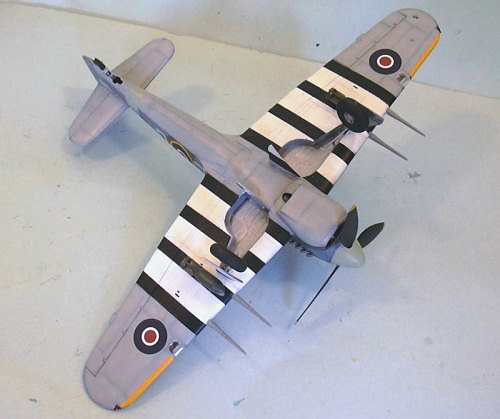 I
first painted the black and white ID stripes on the lower wings, then masked
them off, followed by the Sky rear fuselage stripe which I masked off. The
model was then painted with Xtracrylix Ocean Grey, RAF Dark Green, and Sea Grey
Medium, using the camouflage pattern in the old Profile Publications “Camouflage
and Markings” book. When all was dry, I gave the model a coat of Xtracrylix
Gloss Varnish.
I
first painted the black and white ID stripes on the lower wings, then masked
them off, followed by the Sky rear fuselage stripe which I masked off. The
model was then painted with Xtracrylix Ocean Grey, RAF Dark Green, and Sea Grey
Medium, using the camouflage pattern in the old Profile Publications “Camouflage
and Markings” book. When all was dry, I gave the model a coat of Xtracrylix
Gloss Varnish.
Decals:
I had picked up an old Aeromaster 1/32 sheet at the same time I bought the model, and used this in place of the kit decals. I chose to do the 181 Squadron Typhoon “Cemetery Bait,” since I was using the kit-supplied bombs.
| FINAL CONSTRUCTION |
When the decals were set and the model had been washed, I applied two coats of Xtracrylix Clear Flat Varnish. I then attached the prop, the landing gear, the exhausts, and the canopy lid and door. I made a canopy lid from a sheet of Butyrate.
| CONCLUSIONS |
This kit is easy to build and makes up into an accurate early-model Typhoon. One could super detail the cockpit if they wanted - I did the kit basically out of the box to demonstrate it is still viable. At $20, the kit is much more affordable than the MDC kit, which is ten times that (and not necessarily ten times better, though it makes into a nice model). I personally like the car door Typhoon the best, and am quite happy to have this sitting on the shelf next to the Spitfires, which it dwarfs with its bulldog appearance. The model is proof that just because a kit is old doesn’t mean it isn’t still good.
July 2007
Copyright Modeling Madness.com
If you would like your product reviewed fairly and fairly quickly, please contact the editor or see other details in the Note to Contributors.